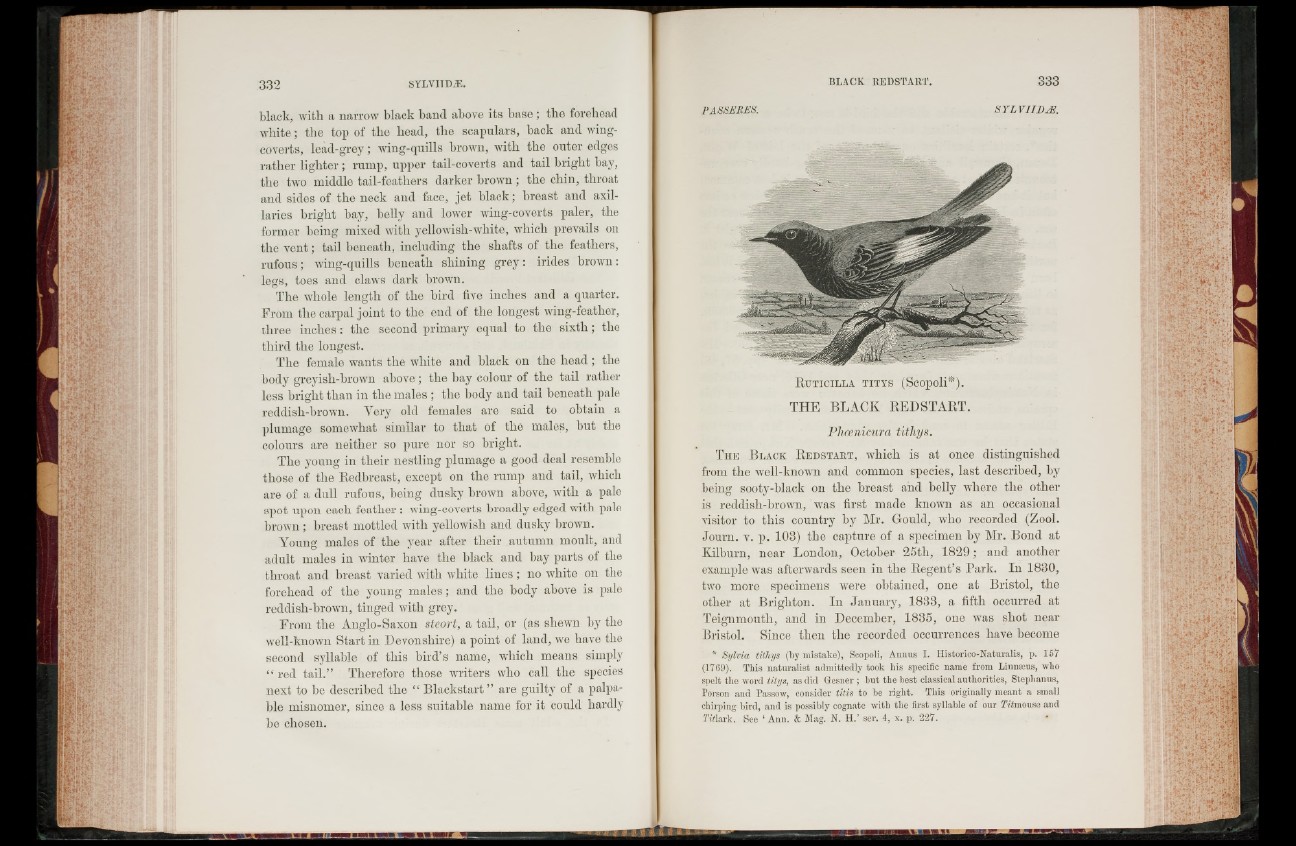
black, with a narrow black band above its base ; the forehead
white; the top of the head, the scapulars, back and wing-
coverts, lead-grey; wing-quills brown, with the outer edges
rather lighter; rump, upper tail-coverts and tail bright bay,
the two middle tail-feathers darker brown ; the chin, throat
and sides of the neck and face, jet black; breast and axil-
laries bright bay, belly and lower wing-coverts paler, the
former being mixed with yellowish-white, which prevails on
the v en t; tail beneath, including the shafts of the feathers,
rufous; wing-quills beneath shining grey: irides brown:
legs, toes and claws dark brown.
The whole length of the bird five inches and a quarter.
From the carpal joint to the end of the longest wing-feather,
three inches: the second primary equal to the six th ; the
third the longest.
The female wants the white and black on the h e ad ; the
body greyish-brown above ; the bay colour of the tail rather
less bright than in the males ; the body and tail beneath pale
reddish-brown. Very old females are said to obtain a
plumage somewhat similar to that of the males, but the
colours are neither so pure nor so bright.
The young in their nestling plumage a good deal resemble
those of the Redbreast, except on the rump and tail, which
are of a dull rufous, being dusky brown above, with a pale
spot upon each feather : wing-coverts broadly edged with pale
brown; breast mottled with yellowish and dusky brown.
Young males of the year after their autumn moult, and
adult males in winter have the black and bay parts of the
throat and breast varied with white lines; no white on the
forehead of the young males; and the body above is pale
reddish-brown, tinged with grey.
From the Anglo-Saxon steort, a tail, or (as shewn by the
well-known Start in Devonshire) a point of land, we have the
second syllable of this bird’s name, which means simply
“ red tail.” Therefore those writers who call the species
next to be described the “ Blackstart ” are guilty of a palpable
misnomer, since a less suitable name for it could hardly
be chosen.
PASSE RES. S Y L VUD/E.
R tJT IC IL L A t i t y s (Scopoli*).
THE BLACK REDSTART.
Plioenicura tithys.
T h e B la ck R e d s t a r t , which is at once distinguished
from the well-known and common species, last described, by
being sooty-black on the breast and belly where the other
is reddish-brown, was first made known as an occasional
visitor to this country by Mr. Gould, who recorded (Zool.
Journ. v. p. 103) the capture of a specimen by Mr. Bond at
Kilburn, near London, October 25th, 1829; and another
example was afterwards seen in the Regent’s Park. In 1830,
two more specimens were obtained, one at Bristol, the
other at Brighton. In January, 1833, a fifth occurred at
Teignmouth, and in December, 1835, one was shot near
Bristol. Since then the recorded occurrences have become
* Sylvia tithys (by mistake), Scopoli, Annus I. Historico-Naturalis, p. 157
(1769). This naturalist admittedly took his specific name from Linnteus, who
spelt the word titys, as did Gesner ; but the best classical authorities, Stephanus,
Porson and Passow, consider titis to be right. This originally meant a small
chirping bird, and is possibly cognate with the first syllable of our Titmouse and
7'iilark. See ‘ Ann. & Mag. N. H.’ ser. 4, x. p. 227.
v viS'AV'ìfl
I
I
• ’’ -jyJ
■ ■ v ' n